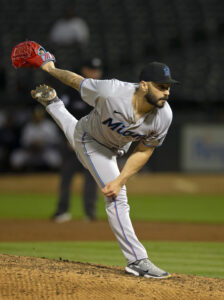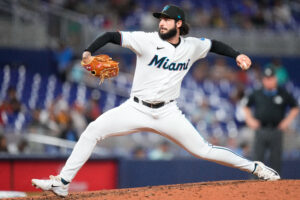Marlins left-hander A.J. Puk was in the Marlins’ rotation to start this year before landing on the injured list but he will be moved back to the bullpen when he’s healthy. Manager Skip Schumaker passed the news along to Christina De Nicola of MLB.com today.
It’s not necessarily a shock that the Marlins are making this decision since the plan to move Puk to the rotation got off to a horrible start. His first four outings resulted in 14 earned runs allowed over 13 2/3 innings. He struck out 12 opponents but gave out walks to 17 of them before landing on the IL over the weekend due to fatigue in his throwing shoulder.
There was some logic to the plan, as Puk was once a highly-touted prospect in the Athletics’ system who was seen as a future major league starter. However, he required shoulder surgery in 2020 and then also had some other health issues, including a strained left biceps and nerve irritation in his left elbow.
The A’s decided to move Puk to a relief role after those injuries and the initial results were good. In 2022, Puk tossed 66 1/3 innings out of their bullpen with a 3.12 earned run average, striking out 27% of batters faced. They flipped him to the Marlins for JJ Bleday prior to 2023, and Puk continued to have success as a reliever in Miami. His ERA ticked up slightly to 3.97 but his strikeout rate also jumped to 32.2%.
After two years of success as a reliever, it’s understandable why the Marlins thought the time was right for him to see if he could move back to the rotation. From a team standpoint, they had seen their rotation depth thinned out by the trades of Pablo López and Jake Eder, as well as the Tommy John surgery of Sandy Alcántara. Since moving Puk to the rotation, that depth was further thinned by Eury Pérez also requiring Tommy John, while Edward Cabrera and Braxton Garrett battled less-significant injuries.
But the poor results and Puk’s shoulder injury seem to have convinced the Marlins to give up on the experiment, at least for now. He’ll move back to the bullpen when he returns from the IL and will hopefully re-establish himself in that role.
The Marlins can control Puk for two more seasons beyond the current campaign. Given their poor start this season, they are trending towards being sellers at the deadline this summer. Puk could perhaps be made available but the extra years of control also mean that they could decide to hang onto him.
The Miami rotation currently consists of Cabrera, Jesús Luzardo, Trevor Rogers and Ryan Weathers. Tonight’s starter is Sixto Sánchez but he’s unlikely to give the club much length since he’s mostly been pitching single-inning appearances this year and hardly pitched at all in the three previous years due to ongoing shoulder problems.
Schumaker seems open-minded about Sánchez taking the ball again, telling De Nicola it depends on how things go tonight, but Garrett is also nearing a return. Per De Nicola, the lefty is planned for four innings and/or 60 pitches in a Triple-A rehab start on Friday.

